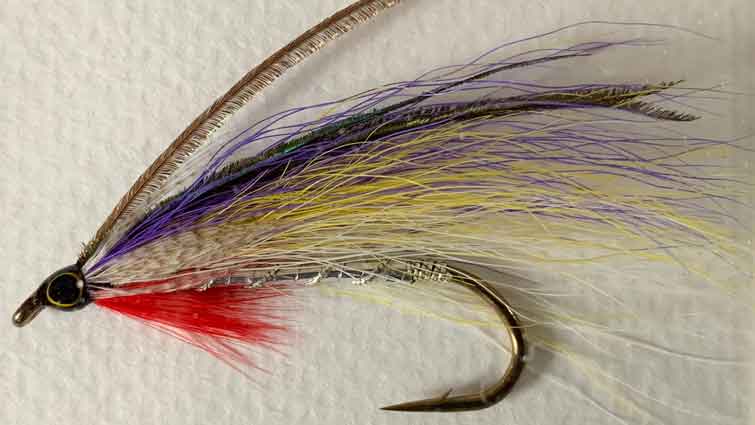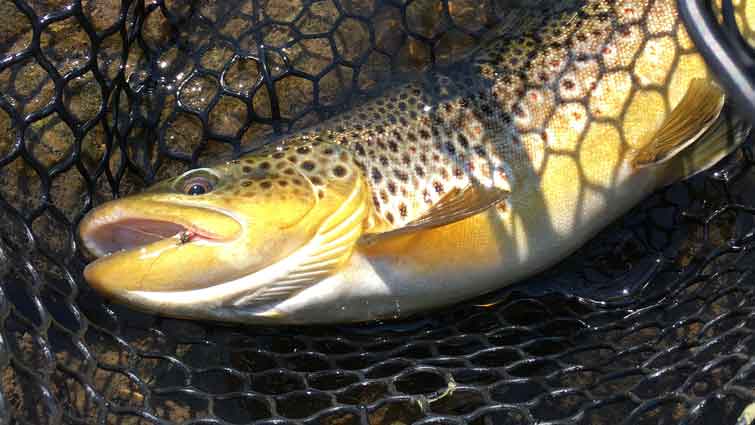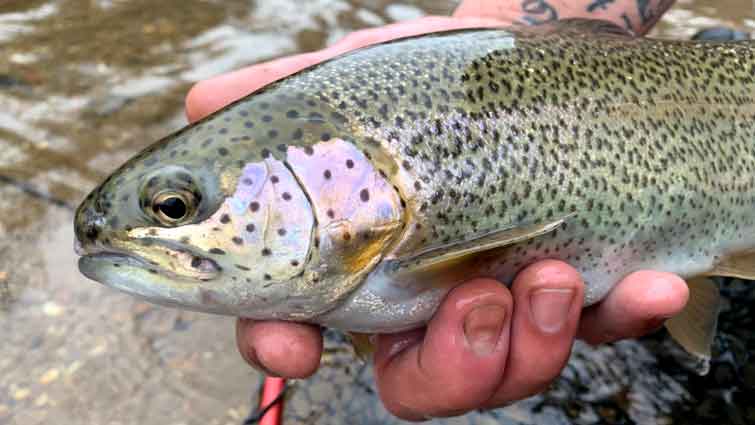A "wet fly" can be described as any type of fly that sinks below the surface of the water with a soft hackle. The name comes from the fact that such flies are designed to sink underwater after being cast into the water. The term "Wet Fly" has been interchangeably used between modern nymphing and traditional wet fly swinging.

Some of the best classical wet flies are:
- The Black Spider developed originally in the 1850s and is still a popular fly today.
- The Silver Doctor #8 was developed by Tom Hilton and developed into a pattern called the Silver Hilton in the early 1950s.
- The Gold Ribbed Hare's Ear is another tremendous wet fly with origins dating back to the 1920s.
It can be challenging to determine which wet fly is the best, but these three are some of the most well-known and often copied patterns out there. They're all extremely effective and will work under almost any conditions. This article will highlight some of the best wet flies, starting in the late 1800s and going through modern times.

The History of Wet Flies
With the advance of modern fishing equipment in the late 1800s, anglers began experimenting with new ways to catch fish. Around this time, wet flies were being developed and used more often than dry flies or fly fishing. This was because wet flies are much easier to cast since they don't float away when hooked.
A little more than two centuries ago, Scottish angler John Wilson, a renowned Scottish professor, writer, poet, and outdoorsman who was running short of flies, fastened the petals of buttercups to his hook to give his bait a fly-like appearance. This technique was so effective that it resulted in the creation of a fly with a yellow silk body known as The Professor.

Veterinarian John Wilson tied the first Professor and Blue Professor while his brother, zoologist James Wilson, created the Grizzly King and Queen of the Waters. It's a very accomplished family. The dressings on all three Professors are similar save for the body color of the silk floss body.
One of the best-known fly-tyers of the mid-1800s is Robert Wilson from Scotland, who published many books on fishing during his lifetime. Even though he's not well known by anglers today, he did help create some prevalent wet flies, including:

The Silver Doctor
In 1850, John Wright created the Silver Doctor salmon fly, initially intended as a trout fly. The Silver Doctor is one of the few silver-bodied salmon flies and is still popular with anglers today.
The fly was exported to the Americas, where it became more popular still, finding great acceptance in Canada and the northern U.S. Many versions have been done of this fly over the last century, including hair-wings, bucktails, streamers, wet fly reductions, and countless variations of the feather wing salmon fly itself. For decades, they have tempted:
- Brook trout
- Rainbows
- Steelhead
- Smallmouth bass, and of course,
- Salmon

The Professor
The Professor was originally a winged wet fly, like most other flies before the 20th century. It quickly earned a reputation among anglers and became well-known in American fly boxes and fishing literature.
The Professor is usually tied using a yellow silk body and a silver tinsel ribbing. There is some controversy over the feathers used to make the wing, but typically they're made of a wood duck feather with two or three golden pheasant neck feathers on each side.

The Black Spider
In the early 1800s, fishing for trout was limited mainly to lakes and ponds where insects were plentiful. These insects were so crucial that there wasn't even a complete fly-fishing tackle store in London until 1836! The new wave of artificial flies didn't come from England, though. They came from France, where anglers started using mousetails instead of natural insect larvae as bait because they looked more natural underwater.
Around 1863, a fly-dresser from Bristol combined the best of both worlds by blending materials from French mousetails with sections from black house spiders to create his version of the Black Spider.
The new patterns were an instant success and were widely imitated. As early as 1898, over thirty different versions were made in England.
As new ways to catch fish were being developed in the late 1800s around this time, wet flies became more commonly used than dry flies or fly fishing. Wet flies are easier to cast since they don't float away when hooked. Even though wet flies are much less common today than in the mid to late 1800s, plenty of great patterns are still available for fly fishers.
Best Wets Flies of the 21st Century
Many of these patterns were developed as "homages," meaning they're similar to or copied from original wet flies that date back to the 1900s or earlier. Some are updated versions with modern materials, while others retain their old names and classic styles:
- The Black Spider. This is one of the oldest and most iconic wet flies in existence. It's not precisely clear who originally came up with this style, but there are quite a few stories behind it, including its origin as a remedy for headaches.
- The Black Bomber. Originally called "The Grouse Fly," Tom Cramer invented it in the 1970s. It's very similar to the original patterns with slight differences, including some materials used for dubbing on the body. Additionally, there are additional options for color depending on water conditions.
- The Blue Charm. Also known as "The Miller's Thrill," which was initially tied by Bob Lindner in 1923.
- The Silver Hilton. The Silver Hilton #8 was developed by Tom Hilton in 1948 and continues to be a popular pattern today among anglers worldwide.
- The Hare's Ear Emerger. This fly is also another tremendous wet fly pattern that first became popular in the 1920s and continues to be a go-to option for anglers worldwide.
Modern Wet Flies (Nymphs)
As far as modern wet flies are concerned, there are plenty of great patterns available worldwide. The above list only scratches the surface, and there are hundreds, if not thousands, of other patterns that anglers use today. The best way to find the perfect wet fly for any body of water is to experiment with different styles and sizes. The new name for a wet fly is called a nymph. Some people still reference nymph patterns as wet flies but the more common term today is “Nymph Fly Fishing.”
Some of the best wet flies today include:

San Juan Worm
The San Juan Worm is a fly pattern based on an aquatic worm (or annelid). San Juan Worms are recognized for their simplicity, durability, and versatility, as they may be fished all year round and in nearly any water body. They are most often used to catch trout and other panfish (like bluegill).
The San Juan worm may grow to be roughly 1.5-2 inches long. Many similar worms may be found in many rivers, which is one of the worm's advantages.
The most popular colors for San Juan Worms are red, tan, white, and pink. Purple, yellow, hot pink, and fluorescent orange are all excellent hues to use. To make some fantastic San Juan Worms, you may also utilize pearl core braid, leather strips, chamois strips, and micro ultra chenille.
The worm was originally developed by a fly fisherman on the San Juan River in New Mexico, according to its name. The red bloodworms are abundant in the San Juan River, and this fisherman wanted to imitate them with a fly effectively.

Copper John
The Copper John Nymph imitates mayflies and stoneflies. Trout are fans of these tiny insects, and they can be found in the Spring, Summer, Fall, especially during the hatch.
The Copper John Nymph can be used in slow, fast, and highly-flowing rivers, where trout love to stay hidden on the bottom. It is great for nymphing because it imitates a mayfly's size and life cycle and because it is made of copper.
This shiny metal attracts fish with its brightness and reflects light underwater. Its silver coloration makes this fly easily go unnoticed by trout even though they might be very close to it.

Zebra Midge
The Zebra Midge is a nymph that disguises itself as midge pupae and/or budding midges. The Zebra is simply made up of a size 16-24 shrimp/scud hook wrapped in colored thread with a 2 or 3mm tungsten bead head of matching metallic finish.
Midges are tiny, translucent worms with red, black, olive, and other hues. They hang in mid-water from an indicator to resemble small worms. In deeper lakes, you may suspend them from a marker. You may also strip them through the water in shallower lakes, especially if there is no wind.

Bead Head Pheasant Tail Nymph
The Pheasant Tail Nymph imitates midges, one of the most attractive insects for trout. This fly is also one of the most widely used nymphs because it works in almost every situation! If you are fishing a larger lake or reservoir, fast-flowing freestone river, low gradient coastal streams, or even spring creeks, this might be the option for you.
The Pheasant Tail Nymph's popularity is due to its effectiveness. It closely resembles the natural insect because it has a slender shape, resembling small worms and grubs more than any other type of insect. It is an excellent general-purpose nymph that can be used for a variety of species, including trout.
Depending on where you live, the Pheasant Tail Nymph could make up much of your fly box - because it works in all conditions! If you fish for trout in lakes or freestone rivers, this might be one of your go-to options anytime you need to add some extra weight (or want to mimic something smaller).

Blue Winged Olive
A blue-winged olive is a non-scientific name for a fly belonging to the Baetis fly family. They are mayflies with dark wings and olive bodies. These tiny flies are preyed on by trout.
Blue Winged Olives are known for hatching in late winter or early spring, depending on where you live. However, they also hatch at night and into the evening during the summer months. Trout gorge themselves when eating these tasty morsels! Blue-winged olives are usually grouped together because of their short life cycle. They hatch very quickly, so it's easy for them to be confused with other mayflies.
The Blue Wing Olive imitates small mayflies with olive bodies and dark wings (Baetis species). It is an excellent choice when caddisflies or tiny black flies hatch because it matches their shade of olive almost perfectly! The tiny size of this nymph imitates the emerging adults caught right before they emerge from their shucks.
Blue Winged Olives are an excellent fly for trout, especially in fast-flowing rivers. They may also be used in small streams and ponds; the water needs to be reasonably clean. The Baetis Nymph is an excellent imitation of a blue-winged olive mayfly - mainly because there are not many that look similar to this specific bug! It is typically tied with a bead head and tungsten beads that imitate nymphs.
The Baetis Nymph can be tied in different colors (brown, black, green, gray) to match the different hues of mayflies that fly during the day or at night. This fly is also excellent for Rainbow Trout and Grayling because it features a shuck - basically a camouflaged sheath around the body - allowing the bug to blend into its surroundings.
Conclusion
The invention of wet flies would open up a whole new chapter in angling, and the history of this type of fishing has been well documented through paintings and illustrations. From the 1800s to the late 1900s, various types of wet flies evolved.
Today's anglers still enjoy fishing with wet flies because you can fish with them in several ways, depending on your target species.
Some flies imitate nymphs. Some are very lifelike imitations of larvae or worms that live at the bottom of rivers and ponds.
As you can see, numerous wet flies are famous for fishing today. Any fly fisherman worth their weight in the fly line will have a few different wet flies in their box. There are plenty of great resources out there to find lots more patterns that work well for any body of water, big or small! This list only covers some of the best-known patterns, including classic styles and modern options.





1 comment
Trevor Cuffy
Very interesting thanks for sharing!
Very interesting thanks for sharing!